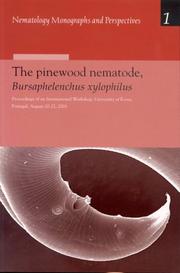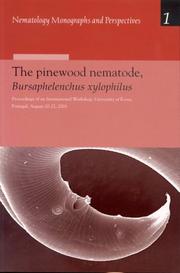| Listing 1 - 10 of 12 | << page >> |
Sort by
|
Book
ISBN: 1281757179 9786611757175 1402084552 1402084544 904817886X Year: 2008 Publisher: Dordrecht : Springer,
Abstract | Keywords | Export | Availability | Bookmark
 Loading...
Loading...Choose an application
- Reference Manager
- EndNote
- RefWorks (Direct export to RefWorks)
The pinewood nematode (PWN), Bursaphelenchus xylophilus, the causal agent of pine wilt disease (PWD), is a serious pest and pathogen of forest tree species, in particular among the genus Pinus. It was first reported from Japan in the beginning of the XXth century, where it became the major ecological catastrophe of pine forests, with losses reaching over 2 million m3/ year in the 1980s. It has since then spread to other Asian countries such as China, Taiwan and Korea, causing serious losses and economic damage. In 1999, the PWN was first detected in the European Union (EU), in Portugal, and immmediately prompted several government (national and EU) actions to assess the extent of the nematode’s presence, and to contain B. xylophilus and its insect vector (Monochamus galloprovincialis) to an area with a 30km radius in the Setúbal Peninsula, 20 km south of Lisbon. International wood trade, with its political as well as economic ramifications, has been seriously jeopardized. The origin of the population of PWN found in Portugal remains elusive. Several hypotheses may be considered regarding pathway analysis, basically from two general origins: North America or the Far East (Japan or China). World trade of wood products such as timber, wooden crates, palettes, etc… play an important role in the potential dissemination of the pinewood nematode. In fact, human activities involving the movement of wood products may be considered the single most important factor in spreading of the PWN. Despite the dedicated and concerted actions of government agencies, this disease continues to spread. Very recently (2006), in Portugal, forestry and phytosanitary authorities (DGRF and DGPC) have announced a new strategy for the control and ultimately the erradication of the nematode, under the coordination of the national program for the control of the pinewood nematode (PROLUNP). Research regarding the bioecology of the nematode and insect as well as new detection methods, e.g., involving real-time PCR, has progressed since 1999. International agreements (GATT, WTO) and sharing of scientific information is of paramount importance to effectively control the nematode and its vector, and thus protect our forest ecosystems and forest economy.
Pinewood nematode. --- Pinewood nematode --- Conifer wilt. --- Pine --- Control. --- Diseases and pests --- Aphelenchoides lignophilus --- Aphelenchoides xylophilus --- Bursaphelenchus lignicolus --- Bursaphelenchus lignophilus --- Bursaphelenchus xylophilus --- Laimaphelenchus lignophilus --- Pine wood nematode --- Bursaphelenchus --- Pine wilt disease --- Wilt disease of pine --- Wilt of conifers --- Conifers --- Nematode diseases of plants --- Wilt diseases --- Pines --- Pinus --- Pinaceae --- Forests and forestry. --- Plant diseases. --- Invertebrates. --- Plant Ecology. --- Forestry. --- Plant Pathology. --- Botany --- Plants --- Ecology --- Invertebrata --- Animals --- Communicable diseases in plants --- Crop diseases --- Crops --- Diseases of plants --- Microbial diseases in plants --- Pathological botany --- Pathology, Vegetable --- Phytopathology --- Plant pathology --- Vegetable pathology --- Agricultural pests --- Crop losses --- Diseased plants --- Phytopathogenic microorganisms --- Plant pathologists --- Plant quarantine --- Forest land --- Forest lands --- Forest planting --- Forest production --- Forest sciences --- Forestation --- Forested lands --- Forestland --- Forestlands --- Forestry --- Forestry industry --- Forestry sciences --- Land, Forest --- Lands, Forest --- Silviculture --- Sylviculture --- Woodlands --- Woods (Forests) --- Agriculture --- Natural resources --- Afforestation --- Arboriculture --- Logging --- Timber --- Tree crops --- Trees --- Pathology --- Diseases --- Wounds and injuries --- Phytoecology --- Vegetation ecology --- Plant pathology. --- Plant ecology. --- Floristic ecology

Abstract | Keywords | Export | Availability | Bookmark
 Loading...
Loading...Choose an application
- Reference Manager
- EndNote
- RefWorks (Direct export to RefWorks)
Conifer wilt --- Pine --- Pinewood nematode --- Diseases and pests

ISBN: 9789047413097 9789004132672 Year: 2004 Publisher: Leiden; Boston : BRILL
Abstract | Keywords | Export | Availability | Bookmark
 Loading...
Loading...Choose an application
- Reference Manager
- EndNote
- RefWorks (Direct export to RefWorks)
According to the European Plant Protection Organization, the pinewood nematode (PWN), Bursaphelenchus xylophilus is a quarantine organism at the top of the list of the pathogenic species. PWN may be found in North America (Canada, USA and Mexico) and in East Asia (Japan, Korea, China and Taiwan) and has a highly destructive capability towards conifers, in a relatively short time, causing serious economic damage in Japan, China and Korea. This nematode surveying is extremely important and a correct identification of nematode species associated with conifers is essential. Several conifers species are very susceptible (Pinus sylvestris, Pinus nigra and Pinus pinaster), the last one (maritime pine) is a particulary important economic specie in Portugal, and in southern Europe. In 1999, this nematode was found and identified for the first time in Portugal and in Europe. During 1999 and 2000, the Portuguese government, following an alert provided to European Community officials initiated an extensive national survey. During 2000 and 2001, research has been carried out regarding the morphobiometric as well as molecular (DNA: ITS-RFLP) characterization of the collected populations, as well as closely related species of Bursaphelenchus. The book details the Proceedings of an international workshop held at the University of Évora in 2001, covering all major aspects of the bioecology of the pinewood nematode (PWN), Bursaphelenchus xylophilus, its insect vectors and effects on the tree. Topics covered are: global issues and national surveys; morphology and molecular methods of identification of PWN; ecology and epidemiology; quarantine issues; tree physiology, resistance and histopathology; biology of PWN and relationships to its cerambycid vectors; control methods. General quarantine and political views are also presented.
Conifer wilt --- Pine --- Pinewood nematode --- Diseases and pests
Book
Year: 1983
Abstract | Keywords | Export | Availability | Bookmark
 Loading...
Loading...Choose an application
- Reference Manager
- EndNote
- RefWorks (Direct export to RefWorks)
Digital
ISBN: 9781402084553 Year: 2008 Publisher: Dordrecht Springer Science+Business Media B.V
Abstract | Keywords | Export | Availability | Bookmark
 Loading...
Loading...Choose an application
- Reference Manager
- EndNote
- RefWorks (Direct export to RefWorks)
General ecology and biosociology --- Plant physiology. Plant biophysics --- Invertebrates --- Forestry --- systematische plantkunde --- invertebraten --- bossen
Book
ISBN: 9782760533165 Year: 2012 Publisher: Québec : Presses de l'Université du Québec,
Abstract | Keywords | Export | Availability | Bookmark
 Loading...
Loading...Choose an application
- Reference Manager
- EndNote
- RefWorks (Direct export to RefWorks)
Community and college --- Community development --- Universities and college --- Universities and colleges --- Développement communautaire --- Relations université-collectivité --- Universités --- Université --- Public services. --- Services à la collectivité. --- Développement communautaire --- Relations université-collectivité --- Universités --- Université --- Services à la collectivité.
Book
ISBN: 3030282473 3030282465 Year: 2019 Publisher: Cham : Springer International Publishing : Imprint: Springer,
Abstract | Keywords | Export | Availability | Bookmark
 Loading...
Loading...Choose an application
- Reference Manager
- EndNote
- RefWorks (Direct export to RefWorks)
This book describes the state of the art across the broad range of spectroscopic techniques used in the study of biological systems. It reviews some of the latest advances achieved in the application of these techniques in the analysis and characterization of small and large biological compounds, covering topics such as VUV/UV and UV-visible spectroscopies, fluorescence spectroscopy, IR and Raman techniques, dynamic light scattering (DLS), circular dichroism (CD/SR-CD), pulsed electron paramagnetic resonance techniques, Mössbauer spectroscopy, nuclear magnetic resonance, X-ray methods and electron and ion impact spectroscopies. The second part of the book focuses on modelling methods and illustrates how these tools have been used and integrated with other experimental and theoretical techniques including also electron transfer processes and fast kinetics methods. The book will benefit students, researchers and professionals working with these techniques to understand the fundamental mechanisms of biological systems.
Spectroscopy. --- Medical physics. --- Cytology --- Spectroscopy and Microscopy. --- Spectroscopy/Spectrometry. --- Medical and Radiation Physics. --- Biological Techniques. --- Atomic/Molecular Structure and Spectra. --- Research --- Methodology. --- Cell biology --- Cellular biology --- Biology --- Cells --- Cytologists --- Health physics --- Health radiation physics --- Medical radiation physics --- Radiotherapy physics --- Radiation therapy physics --- Biophysics --- Physics --- Analysis, Spectrum --- Spectra --- Spectrochemical analysis --- Spectrochemistry --- Spectroscopy --- Chemistry, Analytic --- Interferometry --- Optics --- Radiation --- Wave-motion, Theory of --- Absorption spectra --- Light --- Spectroscope --- Qualitative --- Radioisotopes in biology. --- Radiobiology --- Spectrometry --- Microscopy. --- Radiation. --- Biology—Technique. --- Atomic structure . --- Molecular structure . --- Structure, Molecular --- Chemical structure --- Structural bioinformatics --- Structure, Atomic --- Atomic theory --- Radiology --- Analysis, Microscopic --- Light microscopy --- Micrographic analysis --- Microscope and microscopy --- Microscopic analysis --- Optical microscopy --- Analytical chemistry
Book
ISBN: 9781402084546 9781402084553 Year: 2008 Publisher: Dordrecht Springer Science+Business Media B.V.
Abstract | Keywords | Export | Availability | Bookmark
 Loading...
Loading...Choose an application
- Reference Manager
- EndNote
- RefWorks (Direct export to RefWorks)
The pinewood nematode (PWN), Bursaphelenchus xylophilus, the causal agent of pine wilt disease (PWD), is a serious pest and pathogen of forest tree species, in particular among the genus Pinus. It was first reported from Japan in the beginning of the XXth century, where it became the major ecological catastrophe of pine forests, with losses reaching over 2 million m3/ year in the 1980s. It has since then spread to other Asian countries such as China, Taiwan and Korea, causing serious losses and economic damage. In 1999, the PWN was first detected in the European Union (EU), in Portugal, and immmediately prompted several government (national and EU) actions to assess the extent of the nematode's presence, and to contain B. xylophilus and its insect vector (Monochamus galloprovincialis) to an area with a 30km radius in the Setúbal Peninsula, 20 km south of Lisbon. International wood trade, with its political as well as economic ramifications, has been seriously jeopardized. The origin of the population of PWN found in Portugal remains elusive. Several hypotheses may be considered regarding pathway analysis, basically from two general origins: North America or the Far East (Japan or China). World trade of wood products such as timber, wooden crates, palettes, etc ¦ play an important role in the potential dissemination of the pinewood nematode. In fact, human activities involving the movement of wood products may be considered the single most important factor in spreading of the PWN. Despite the dedicated and concerted actions of government agencies, this disease continues to spread. Very recently (2006), in Portugal, forestry and phytosanitary authorities (DGRF and DGPC) have announced a new strategy for the control and ultimately the erradication of the nematode, under the coordination of the national program for the control of the pinewood nematode (PROLUNP). Research regarding the bioecology of the nematode and insect as well as new detection methods, e.g., involving real-time PCR, has progressed since 1999. International agreements (GATT, WTO) and sharing of scientific information is of paramount importance to effectively control the nematode and its vector, and thus protect our forest ecosystems and forest economy.
Book
ISBN: 9783030282479 Year: 2019 Publisher: Cham Springer International Publishing :Imprint: Springer
Abstract | Keywords | Export | Availability | Bookmark
 Loading...
Loading...Choose an application
- Reference Manager
- EndNote
- RefWorks (Direct export to RefWorks)
Book

ISBN: 3031451554 Year: 2023 Publisher: Cham : Springer,
Abstract | Keywords | Export | Availability | Bookmark
 Loading...
Loading...Choose an application
- Reference Manager
- EndNote
- RefWorks (Direct export to RefWorks)
| Listing 1 - 10 of 12 | << page >> |
Sort by
|

 Search
Search Feedback
Feedback About UniCat
About UniCat  Help
Help News
News